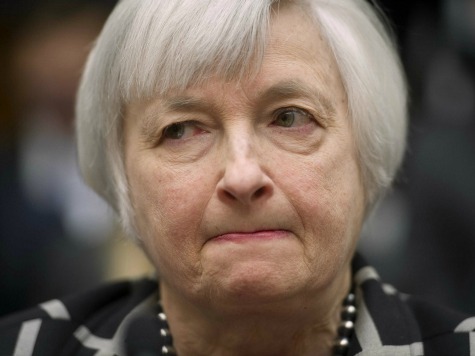
Janet Yellen, in her first press conference as the new Federal Reserve Chair, said the U.S. economy is expanding by close to 3% despite harsh weather. She added that hiring and wage growth are faster than expected, causing unemployment to fall more than expected and the percentage of Americans in the workforce to expand for the first time in seven years.
Because of better-than-expected economic performance, the Fed will reduce its monthly purchase of bonds by $10 billion. The markets responded by pushing up interest rates and the value of the dollar, while bond and gold prices suffered big losses. Reading between the lines, the Fed has begun to tighten interest rates to curb any outbreak of inflation.
In Chair Yellen’s confirmation hearings last month, she mounted a vigorous public defense of the merit of the Fed’s massive bond purchase program known as quantitative easing. Although many Senators were still very suspicious that the Fed intended to use inflation to debase the value of the U.S. dollar, conservatives on the Senate Banking Committee were impressed with Yellen’s transparency and willingness to engage in an open conversation regarding the Fed’s often secretive monetary policy. Janet Yellen indicated that she would respond to inflation by tightening monetary policy.
Most brokerage firm economists were quick Wednesday to try to reassure their clients that nothing is new and interest rates are not going to rise in the foreseeable future. The Wall Street Journal‘s Jon Hilsenrath commented that Janet Yellen’s first FOMC statement indicated “explicitly for the first time that it likely would keep short-term rates lower than normal, even after inflation and employment return to their longer-run trends.” The Journal added that the Fed’s promise since 2012 to not raise interest rates from near zero percent until the jobless rate fell to 6.5% is now being replaced by an even lower unemployment rate, “which officials have come to see as too limited an indicator of the labor market’s health.”
But the FOMC statement highlighted that ten of sixteen Fed officials said they saw the Fed’s benchmark interest rate rising to 1% or more by the end of 2015, an increase since December, when only seven officials saw rates at or above the 1% level. Twelve of those sixteen officials also now expect the rate to be at or above 2% by the end of 2016. This change is dramatic for an organization whose FOMC monthly statements have indicated its intention of keeping interest rates at virtually zero since 2009.
Chairman Yellen most tellingly commented that labor wage growth had been very depressed at around 2% per year, but she expected this number to rise to 3-4%. This is the first time in seven years that the Fed has been expecting wages to grow at a faster rate than inflation expectations. Cutting bond purchases and expecting an increase in wages and the number of people in the work force are classic tipoffs that Janet Yellen’s Fed has begun its tightening cycle and interest rates are headed higher.

COMMENTS
Please let us know if you're having issues with commenting.